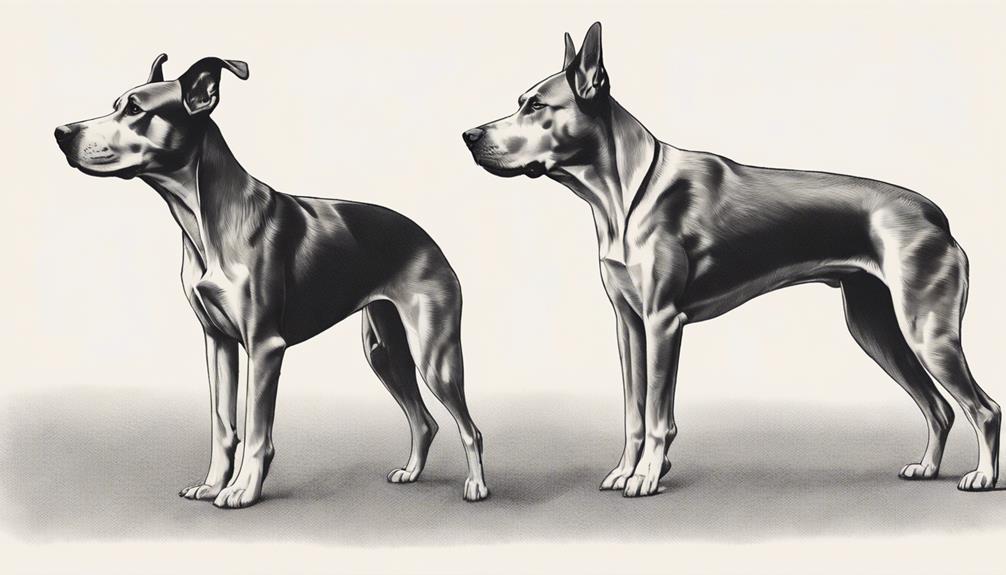Why Do Dogs Show Pain Differently?
Imagine you're in a room with two dogs. One lets out a loud yelp at the slightest touch, while the other remains stoic even when injured. Have you ever wondered why dogs exhibit such varying responses to pain?
Understanding these differences can provide crucial insights into their well-being. From subtle changes in behavior to more overt signs like vocalizations or altered eating habits, dogs communicate distress in a multitude of ways.
But why do they show pain differently? Stay tuned to uncover the fascinating reasons behind this intriguing phenomenon.
Vocalizations
When dogs are in pain, they may express it through various vocalizations such as whining or yelping. Whimpering is a common way dogs communicate discomfort. It often indicates mild to moderate pain and serves as a signal for help or attention. If your dog starts howling unexpectedly, it could be a sign of severe pain or distress. Howling is a louder and more prolonged vocalization compared to whimpering, usually suggesting a sense of urgency or intense discomfort.
If your dog is whimpering or howling, it's crucial to pay attention and assess the situation promptly. These vocalizations are your furry friend's way of letting you know something is wrong. Providing comfort, checking for any visible injuries, or consulting a veterinarian if the vocalizations persist can help address the pain your dog is experiencing. Remember, understanding your dog's vocal cues is essential for recognizing and addressing their pain effectively.
Body Language
You can often gauge a dog's pain levels by observing their body language closely. When a dog is in pain, their body will communicate distress signals that can help you understand their discomfort.
Here are some key body language indicators to look out for:
- Tail Wagging: Contrary to popular belief, a dog wagging its tail doesn't always mean they're happy. A stiff, slow wag or a low wag could indicate pain or discomfort.
- Ear Positioning: Dogs typically hold their ears in a natural position when they're at ease. If a dog's ears are pinned back or flattened against their head, it might signal pain.
- Body Posture: A dog in pain may exhibit a tense body posture, with their muscles appearing rigid and their movements restricted.
- Facial Expressions: Watch for signs like a furrowed brow, squinting eyes, or a tight mouth. These facial expressions can reveal a dog's pain levels more accurately than you might think.
Understanding these subtle cues in a dog's body language can help you provide the necessary care and support when they're in pain.
Changes in Behavior
Observing changes in a dog's behavior can provide valuable insights into their well-being and potential pain levels. Dogs exhibit various behavioral cues and communication signals that can indicate discomfort or pain. For instance, a normally energetic and playful dog may become withdrawn or less active when in pain. They might also display signs of irritability or aggression when approached or touched in sensitive areas.
Changes in eating habits can also be a significant indicator of pain. A dog in discomfort may lose interest in food or treats, or they may eat more slowly than usual. Additionally, alterations in grooming behaviors, such as excessive licking or chewing at a particular body part, can suggest pain or discomfort in that area.
Furthermore, pay attention to any reluctance to participate in activities that the dog usually enjoys, like walking, running, or playing fetch. These shifts in behavior can provide crucial clues about your furry friend's well-being and help you address any potential pain they might be experiencing.
Facial Expressions
Facial expressions play a crucial role in understanding a dog's pain and discomfort levels. When assessing your furry friend for signs of distress, paying attention to their facial cues can provide valuable insights into their well-being.
Here are some key points to consider:
- Communication cues: Dogs use their facial expressions to communicate various emotions, including pain. Watch out for signs like narrowed eyes, tension around the mouth, or a furrowed brow, which could indicate discomfort.
- Emotion indicators: Just like humans, dogs display emotions through their facial expressions. Anxious or pained dogs may exhibit behaviors such as lip licking, panting excessively, or avoiding eye contact.
- Subtle changes: Sometimes, the signs of pain in a dog's face can be quite subtle. It's essential to familiarize yourself with your dog's normal expressions to spot any deviations that could signal underlying issues.
- Seek professional help: If you notice persistent changes in your dog's facial expressions or suspect they're in pain, don't hesitate to consult a veterinarian for a thorough evaluation and appropriate management.
Appetite and Eating Habits
Understanding a dog's pain extends beyond facial expressions to include monitoring their appetite and eating habits, which can offer valuable insights into their well-being. One significant sign to watch out for is a decreased appetite. If your dog suddenly shows disinterest in food or eats significantly less than usual, it could indicate they're experiencing pain or discomfort.
Changes in eating habits, such as taking longer to finish meals or refusing treats they typically enjoy, may also be red flags. Moreover, unexplained weight loss can be a concerning indicator of an underlying issue causing pain in your furry friend. If you notice your dog losing weight without a change in their diet or activity level, it's essential to consult a veterinarian promptly to address any potential pain-related problems.
Monitoring your dog's appetite and eating behaviors closely can help you detect signs of pain early and ensure they receive the necessary care and treatment to alleviate their discomfort.
Grooming Habits
Monitoring your dog's grooming habits can provide valuable insights into their overall well-being and potential pain or discomfort they may be experiencing.
- Coat Condition: Pay attention to changes in your dog's coat condition. A dull, dry, or unkempt coat could indicate underlying health issues or discomfort.
- Grooming Techniques: Observe how your dog reacts during grooming sessions. Sudden sensitivity or aversion to being touched in certain areas might signal pain.
- Skin Health: Check for any abnormalities on your dog's skin such as redness, bumps, or sores. These could be signs of irritation, allergies, or infections.
- Shedding Patterns: Note any excessive shedding or bald spots on your dog. Unusual shedding patterns could be a result of stress, poor nutrition, or medical problems.
Posture and Movement

Observing your dog's posture and movement can reveal important clues about their comfort level and potential sources of pain or discomfort. Pay close attention to their weight distribution, as a dog in pain may try to relieve pressure on a certain limb or side. An abnormal gait, revealed through gait analysis, could indicate joint issues or muscle pain. Notice any changes in your dog's muscle tension; increased tension might suggest discomfort or pain in specific areas. Reduced joint mobility could also be a sign of pain, especially in older dogs or those with arthritis.
When observing your dog, watch for signs like limping, stiffness, or reluctance to move. A hunched posture, guarding a specific body part, or avoiding certain movements could all signal pain. If you notice any of these signs, it's essential to consult with your veterinarian to address any underlying issues promptly. By understanding your dog's posture and movement patterns, you can better support their health and well-being.
Response to Touch
When touching your dog, pay attention to their response for indications of pain or discomfort. Dogs may show varying sensitivity levels to touch, and their physical response can provide valuable insights into their well-being.
- Tail Position: Notice if your dog tucks their tail between their legs or holds it unusually low when you touch certain areas. This could indicate discomfort or pain.
- Muscle Tension: Observe if your dog tenses up or flinches when you apply light pressure. Increased muscle tension may suggest sensitivity or pain in that area.
- Vocalization: Listen for any vocal cues such as whimpering, whining, or growling when you touch a specific spot. Dogs may vocalize to communicate discomfort.
- Withdrawal: Watch for signs of withdrawal, such as moving away, licking the area excessively, or avoiding touch altogether. These behaviors can signal that the touch is causing discomfort to your dog.
Understanding your dog's sensitivity levels and interpreting their physical responses to touch can help you identify and address any potential sources of pain or discomfort promptly.
Frequently Asked Questions
Can Dogs Fake Pain Symptoms to Get Attention or Treats?
Dogs can exhibit behavioral manipulation by faking pain symptoms to gain attention or treats. This attention-seeking behavior may involve deception by displaying false pain signals. Some dogs might learn that acting in pain gets them extra care or rewards.
It's essential to observe your dog's overall behavior and consult with a veterinarian to differentiate between genuine pain and attention-seeking tactics. Be attentive to your pet's well-being to ensure they receive proper care and support.
Do Certain Breeds Show Pain Differently Than Others?
Certain breeds may indeed show pain differently than others due to variations in pain signals and perception. Breed variability can impact how dogs express discomfort, making it essential to understand your specific breed's typical behaviors and reactions to pain.
Factors such as breed genetics, size, and temperament can influence how pain is manifested in different breeds. Being attuned to these differences can help you provide appropriate care and support for your furry companion.
How Does a Dog's Age Impact How They Display Pain?
As dogs age, their pain tolerance may decrease, causing them to show pain differently. Behavioral changes in aging dogs, such as decreased activity or increased irritability, can be signs of pain.
It's essential to pay attention to these cues and consult with a veterinarian to address any discomfort your aging dog may be experiencing. Regular check-ups can help manage pain and ensure your furry friend's well-being as they grow older.
Can a Dog's Past Experiences Affect How They React to Pain?
Your dog's past experiences, like past trauma, can greatly influence how they react to pain.
These experiences shape their pain perception and can cause them to display pain differently based on what they've been through.
Being aware of your dog's history can help you better understand their behavior when they're in pain and provide the necessary care and support they need.
Are There Any Alternative Treatments or Therapies That Can Help Manage a Dog's Pain?
When looking for ways to help manage your dog's pain, you might consider alternative treatments like acupuncture therapy or CBD oil usage. These options can offer additional relief and support alongside traditional methods.
Acupuncture therapy targets specific points to alleviate discomfort, while CBD oil can help reduce inflammation and provide calming effects. Consulting with your vet to explore these alternatives could lead to a more holistic approach to managing your dog's pain.
Conclusion
In conclusion, dogs show pain differently through a combination of vocalizations, body language, changes in behavior, facial expressions, appetite and eating habits, grooming habits, posture and movement, and response to touch.
It's important for dog owners to pay attention to these signs and seek veterinary care if they suspect their furry friend is in pain. Understanding how dogs communicate pain can help ensure they receive the care and treatment they need to feel better.
